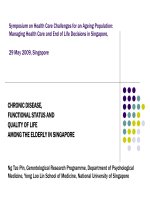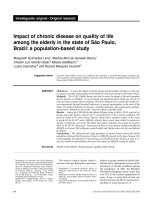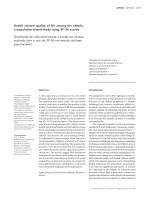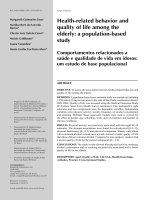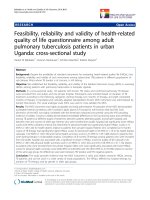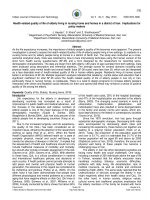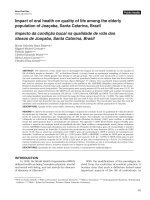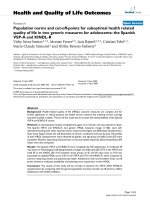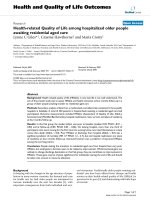Health related quality of life among the elderly: a population-based study using SF-36 survey pdf
Bạn đang xem bản rút gọn của tài liệu. Xem và tải ngay bản đầy đủ của tài liệu tại đây (102.19 KB, 9 trang )
Cad. Saúde Pública, Rio de Janeiro, 25(10):2159-2167, out, 2009
2159
Health related quality of life among the elderly:
a population-based study using SF-36 survey
Qualidade de vida relacionada à saúde em idosos,
avaliada com o uso do SF-36 em estudo de base
populacional
1
Faculdade de Ciências
Médicas, Universidade
Estadual de Campinas,
Campinas, Brasil.
2
Faculdade de Saúde
Pública, Universidade de São
Paulo, São Paulo, Brasil.
3
Faculdade de Medicina,
Universidade de São Paulo,
São Paulo, Brasil.
4
Faculdade de Medicina
de Botucatu, Universidade
Estadual Paulista, Botucatu,
Brasil.
5
Departamento de Medicina,
Universidade Federal de São
Paulo, São Paulo, Brasil.
Correspondence
M. B. A. Barros
Departamento de Medicina
Preventiva e Social,
Faculdade de Ciências
Médicas, Universidade
Estadual de Campinas.
C. P. 6111, Campinas, SP
13083-970, Brasil.
Margareth Guimarães Lima
1
Marilisa Berti de Azevedo Barros
1
Chester Luiz Galvão César
2
Moisés Goldbaum
3
Luana Carandina
4
Rozana Mesquita Ciconelli
5
Abstract
As life expectancy continues to rise, one of the
greatest challenges of public health is to improve
the quality of later years of life. The aim of this
present study was to analyze the quality of life
profile of the elderly across different demograph-
ic and socioeconomic factors. A cross-sectional
study was carried out in two stages, involving
1,958 individuals aged 60 years or more. Health
related quality of life (HRQOL) was assessed us-
ing the SF-36 questionnaire. The lowest scores
were found among measures for vitality, mental
health and general health and the highest among
factors including social functioning and role lim-
itations due to emotional and physical factors.
HRQOL was found to be worse among women,
in individuals at advanced ages, those who prac-
ticed evangelical religions and those with lower
levels of income and schooling. The greatest dif-
ferences in SF-36 scores between the categories
were observed in functional capacity and physi-
cal factors. The results suggest that healthcare
programs for the elderly should take into account
the multi-dimensionality of health and social
inequalities so that interventions can target the
most affected elements of HRQOL as well as the
most vulnerable subgroups of the population.
Aged; Quality of Life; Social Inequity; Question-
naires
Introduction
The progressive rise in life expectancy contrib-
utes to an increase in the prevalence of chronic
illnesses in the elderly population
1
. Despite
suffering from chronic conditions, elderly in-
dividuals can have a good level of health and
remain capable of administering basic survival
activities, their social lives and finances
2
. There-
fore, one of the greatest public health challenges
is to increase the number of years of a healthy
and quality life.
The concept of quality of life encompasses
satisfaction and wellbeing, containing subjec-
tive and multi-dimensional characteristics
3,4
.
Quality of life can be addressed as general quality
of life or health-related quality of life (HRQOL).
The former is a broad-based term that includes
the sense of wellbeing and happiness regardless
of illnesses and dysfunctions. In HRQOL, a mul-
tidimensional approach is employed that takes
into account physical, mental and social aspects
that are more clearly related to symptoms, dis-
abilities and limitations caused by disease
5,6
.
Self-assessed health and health-related quality
of life instruments generate a set of important
health indicators for individuals and popula-
tions and are significant predictors of mortal-
ity, especially in the elderly. In a broad-based
literature review, Idler & Benyamini
7
detected a
greater risk of death in individuals who assessed
their health status as regular or bad compared
ARTIGO ARTICLE
Lima MG et al.
2160
Cad. Saúde Pública, Rio de Janeiro, 25(10):2159-2167, out, 2009
to those with a more favorable self-assessment
of health.
However, HRQOL measurements are not gen-
erated by the Brazilian national health informa-
tion system
8
. Subjective health indicators can be
obtained through health surveys that counterbal-
ance the lack of traditional information systems
and are valuable when it comes to the formula-
tion and assessment of public health policies.
One of the most widely used instruments to
assess health-related quality of life is the SF-36
(Medical Outcomes Study 36-item Short-Form
Health Survey) that is drawn from the Medical
Outcomes Study (MOS) questionnaire published
in English in 1990. The literature on this instru-
ment is documented by the International Qual-
ity of Life Assessment Project (IQOLA)
9
. The SF-
36 contains 36 items combined in eight scales,
which can also be grouped into two components:
physical and mental. SF-36 has been translated
and validated in several languages and cultures.
There are surveys applying the SF-36 in more
than 40 countries
9
. The instrument allows the
measurement of various health dimensions and
can assess the impact of disease as well as the
benefits of treatment. It is also a good predictor
of mortality. In a cohort study with elderly indi-
viduals, Tsay et al.
10
found a greater risk of mor-
tality among those who scored low on the SF-36
measures.
In Brazil, the instrument was translated and
validated by Ciconelli et al.
11
in a study involv-
ing individuals with rheumatoid arthritis. It was
considered suitable for administration under the
socioeconomic and cultural conditions of the
Brazilian population.
Studies developed in other countries demon-
strate that some SF-36 domains, such as vitality
and general health, are more compromised than
others, such as mental health and social function-
ing
12,13
. A number of studies have assessed the
extent to which demographic and socioeconom-
ic conditions are associated with HRQOL using
the SF-36
13,14
and have found significant differ-
ences between subpopulations, which points out
the need for a differentiated approach to public
health planning in order to improve equity.
However, there have been no previously pub-
lished Brazilian population-based studies using
the SF-36 for comparisons with international
data.
The aim of the present study was to provide a
profile of SF-36 scales and analyze the influence
of demographic and socioeconomic factors on
health-related quality of life in an elderly Brazil-
ian population.
Material and methods
This is a cross-sectional population-based study,
developed with data obtained from the Multi-
Center Health Survey in the State of São Paulo
(ISA-SP) carried out in 2001 and 2002 in four ar-
eas of the State of São Paulo, Brazil
15
.
A two-stage stratified cluster sample was ob-
tained. Census tracts were grouped into three
strata according to the percentage of heads of
household with college education: less than 5%,
5% to 25% and over 25%. Ten census tracts were
selected from each stratum totaling 120 sectors in
the four areas. After the fieldwork to update maps,
the selection of households was performed. In
order to obtain satisfactory subpopulation sam-
ple sizes the following gender and age domains
were defined: < 1 year, 1 to 11 years, 12 to 19 year-
old-men, 12 to 19 year-old-women, 20 to 59 year-
old-men, 20 to 59 year-old-women, men aged 60
and over and women aged 60 and over. For each
domain in each study area a minimum sample
size of 200 was estimated, based on a prevalence
of 0.5, an error of 0.07, an alpha error of 0.05 and
a design effect of 2. Considering a possible loss of
20%, 250 individuals were selected for each do-
main
16
. For the present study, only two domains
were included – those with people aged 60 years
or more. Data were collected by trained inter-
viewers directly to the selected individual using
a pre-codified questionnaire. The questionnaire
was mostly made up of closed questions orga-
nized into 19 theme blocks.
The variables analyzed in this study were
obtained from three thematic sets of questions:
health related quality of life, constituted using
the SF-36 and sets of socioeconomic and demo-
graphic characteristics.
The dependent variables were the scores of
the SF-36 scales: physical functioning, role limita-
tions due to physical health problems (referred to
here as role-physical), bodily pain, general health
(general health perceptions), vitality, social func-
tioning, role limitations due to emotional health
problems (referred to here as role-emotional) and
mental health.
The scores were attributed to each item ac-
cording to the proposed methodology
11
. The to-
tal scores from each of the eight domains were
then converted to a scale ranging from 0 to 100,
with higher scores representing better health
11
.
The independent variables of this study were
the demographic and socioeconomic character-
istics: gender; age (60 to 69, 70 to 79 and 80 years
or more); skin color/ethnicity (white and black/
mixed); marital status (with and without spouse);
religion (Catholic, Evangelic, and others or no re-
ligion); monthly per capita family income (less
HEALTH RELATED QUALITY OF LIFE AMONG THE ELDERLY
2161
Cad. Saúde Pública, Rio de Janeiro, 25(10):2159-2167, out, 2009
than 1 minimum wage; 1 to 4 times the minimum
wage; and more than 4 times the minimum sal-
ary); and schooling (0 to 3; 4 to 8; and 9 or more
years of study).
Estimates of means, standard error and con-
fidence intervals were performed for each of the
SF-36 scales. Differences in means according to
demographic and socioeconomic variables were
tested using simple linear regression analysis.
Multiple regression models were used to control
the effect of gender, age and per capita month-
ly income and schooling. All data analysis took
into account the sample design considering the
weights and the intra-cluster correlations. Analy-
ses were performed with Stata 8.0 (Stata Corp.,
College Station, USA) application software.
The ISA-SP project was approved by the Eth-
ics Committees of the School of Public Health
at the University of São Paulo (USP), the School
of Medical Science at the State University of
Campinas (UNICAMP) and the School of Medi-
cine at the State University of São Paulo-Botucatu
(UNESP). All subjects signed a consent form and
the confidentiality of data was assured. The pres-
ent study was approved by the Research Ethics
Committee of the School of Medical Science
(UNICAMP) under protocol number 369/2000.
Results
A total of 1,958 elderly individuals were inter-
viewed: 929 men and 1,029 women, with a mean
age of 69.6 years. Most of the interviewees were
in the 60 to 69 age group (55.8%), lived with a
spouse (58.9%), were Catholic (75.5%) and re-
ferred to themselves as being white (80.2%).
About 75% had a per capita monthly income less
than four times the minimum salary and 42.6%
had less than four years of schooling (Table 1).
Scores of quality of life were lowest in the fol-
lowing dimensions: vitality (64.4), mental health
(69.9) and general health (70.1). Highest scores
were obtained in the following scales: role-emo-
tional (86.1), social functioning (85.9) and role-
physical (81.2) (Table 2).
Women obtained lower scores than men in
all domains except for role-physical (Table 3).
The greatest difference between genders was
found in the physical functioning scale, with a
difference of 9.2 points between mean scores.
Unadjusted analysis of the difference in
scores according to skin color/ethnicity revealed
that white individuals obtained significantly
higher mean scores in the general health scale.
However, this difference failed to remain sig-
nificant in multiple linear regression analysis
(Table 3).
Table 1
Sample characteristics according to demographic and socioeconomic variables. Multi-Center
Health Survey in the State of São Paulo (ISA-SP), 2001-2002.
Variables/Categories n % (95%CI)
Gender
Male 929 42.7 (39.0-46.3)
Female 1,029 57.2 (53.6-60.9)
Total 1,958
Age (in years)
60-69 1,092 55.8 (51.0-60.6)
70-79 645 33.3 (29.1-37.5)
80 or more 221 10.8 (8.2-13.3)
Schooling (in years)
0-3 844 42.6 (37.6-48.1)
4-8 759 38.2 (34.7-42.1)
9 or more 354 19.0 (14.3-22.9)
Per capita monthly income (multiple of the
minimum wage)
< 1 505 23.4 (19.6-27.1)
1-4 987 51.8 (48.4-55.2)
> 4 466 24.7 (20.6-28.8)
Skin color/Ethnicity
White 1,510 80.2 (76.5-83.8)
Black/Mixed 394 19.8 (16.1-23.4)
Religion
Catholic 1,427 75.5 (72.4-78.6)
Evangelical 305 14.4 (11.5-17.3)
Others/Without religion 214 10.0 (8.2-11.7)
Conjugal situation
With spouse 1,172 58.9 (54,8-63,1)
Without spouse 775 41.0 (36.8-43.1)
Table 2
Mean scores of SF-36 scales. Multi-Center Health Survey in the State of São Paulo (ISA-SP),
2001-2002.
Scales Mean 95%CI Standard error
Physical functioning 71.4 68.9-73.9 1.26
Role-physical 81.2 775-84.8 1.83
Bodily pain 74.2 72.0-76.4 1.09
General health 70.1 68.3-71.8 0.86
Vitality 64.4 62.3-66.5 1.04
Role-emotional 86.1 83.8-88.4 1.16
Social functioning 85.9 83.4-88.5 1.27
Mental health 69.9 68.3-71.5 0.81
Lima MG et al.
2162
Cad. Saúde Pública, Rio de Janeiro, 25(10):2159-2167, out, 2009
Table 3
Mean scores, mean differences and confi dence intervals (95%) of SF-36 scales according to gender, skin color and conjugal situation. Multi-Center Health
Survey in the State of São Paulo (ISA-SP), 2001-2002.
Scales Gender Crude differences Adjusted differences *
Male Female Dif p Dif p
Physical functioning 77.8 (75.5-80.1) 66.7 (63.5-69.9) -11.1 0.000 -9.2 0.000
Role-physical 82.8 (79.4-86.2) 79.9 (75.3-84.5) -2.8 0.194 -1.1 0.585
Bodily pain 77.9 (75.6-80.3) 71.4 (68.7-74.2) -6.4 0.000 -5,7 0.000
General health 72.9 (70.9-74.9) 67.9 (65.5-70.4) -4.9 0.001 -3,9 0.008
Vitality 68.6 (66.6-70.2) 61.2 (58.9-63.5) -7.9 0.000 -6,3 0.000
Role-emotional 90.3 (88.3-92.4) 83.0 (79.6-86.4) -7.3 0.000 -6.4 0.001
Social functioning 88.8 (85.7-90.2) 84.5 (81.2-87.7) -3.5 0.027 -3.4 0.013
Mental health 73.1 (71.2-75.0) 67.5 (65.5-69.5) -5.5 0.000 -5.2 0.000
Skin color/ ethnicity Crude differences Adjusted differences *
White Black/Mixed Dif p Dif p
Physical functioning 71.7 (69.1-74.4) 69.7 (65.6-73.8) -2.0 0.344 -0.1 0. 933
Role-physical 81.7 (77.9-85.4) 77.4 (71.8-83.1) -4.2 0.125 -0.5 0. 849
Bodily pain 74.7 (72.4-77.0) 71.7 (67.5-75.8) -3.0 0.159 -0.1 0. 999
General health 70.6 (68.7-72.5) 66.9 (63.6-70.2) -3.6 0.035 -1.9 0. 297
Vitality 64.6 (62.4-66.7) 63.4 (59.7-67.0) -1.1 0.554 0.6 0. 746
Role-emotional 86.7 (84.1-89.3) 82.9 (76.9-88.8) -3.8 0.252 -2.0 0. 573
Social functioning 86.4 (84.0-88.8) 83.8 (78.6-88.9) -2.6 0.243 -0.7 0.752
Mental health 69.9 (68.2-71.6) 69.7 (67.0-72.3) -0.2 0.848 1. 9 0. 226
Conjugal situation Crude differences Adjusted differences *
With spouse Without spouse Dif p Dif p
Physical functioning 74.6 (72.4-76.8) 67.3 (63.4-71.2) -7.2 0.000 1.0 0.571
Role-physical 82.8 (79.6-86.1) 78.6 (73.5-83.6) -4.2 0.039 -1.6 0.374
Bodily pain 74.7 (72.6-76.8) 73.7 (70.0-77.4) -1.0 0.603 2.9 0.127
General health 70.3 (68.4-72.2) 69.5 (66.6-72.4) -0.7 0.616 2.7 0.078
Vitality 65.4 (63.3-67.5) 62.8 (60.1-65.6) -2.5 0.075 2.2 0.196
Role-emotional 87.2 (85.0-89.4) 84.5 (80.7-88.2) -2.7 0.149 1.6 0.403
Social functioning 87.3 (85.0-89.6) 84.5 (80.9-88.1) -2.8 0.061 -0.4 0.753
Mental health 70.5 (68.5-72.5) 69.1 (66.7-71.4) -1.3 0.352 1.2 0.487
* Differences adjusted by gender, age, per capita income and schooling using multiple linear regression model.
Regarding the mean scores by marital status,
differences between elderly individuals with and
without spouse were no longer significant after
adjusting for gender, age, schooling and per cap-
ita income (Table 3).
Considering the age groups (Table 4), mean
scores diminish progressively with the advance
in age, with statistically significant differences in
all the scales except for mental health and bodily
pain, comparing the age groups “80 or more”
with those aged 60 to 69.
Individuals of the Catholic faith obtained bet-
ter scores than those from Evangelical religion for
role-physical and vitality indicators, even after
adjusting for gender, age, per capita monthly in-
come and schooling (Table 4).
Scores were higher in the strata with higher
income. The greatest differences in mean scores
between the lowest and highest income strata
were found in the following scales: role-physi-
cal (14.1), social functioning (10.4) and physical
functioning (9.7). Differences between income
HEALTH RELATED QUALITY OF LIFE AMONG THE ELDERLY
2163
Cad. Saúde Pública, Rio de Janeiro, 25(10):2159-2167, out, 2009
Table 4
Mean scores, mean differences and confi dence intervals (95%) of SF-36 scales according to age and religion. Multi-Center Health Survey in the State of São
Paulo (ISA-SP), 2001-2002.
Scales Age (in years) Crude
differences
Adjusted
differences *
Crude
differences
Adjusted
differences *
60-69
(1)
70-79
(2)
80 or more
(3)
Dif
(2)-(1)
p
(2)-(1)
Dif
(2)-(1)
p
(2)-(1)
Dif
(3)-(1)
p
(3)-(1)
Dif
(3)-(1)
p
(3)-(1)
Physical functioning 78.7 (76.0-80.7) 66.3 (61.8-70.8) 47.9 (43.4-52.4) -12.4 0.000 -11.5 0.000 -30.8 0.000 -29.1 0.000
Role-physical 86.1 (83.2-88.9) 75.4 (68.4-82.3) 70.9 (62.4-79.3) -10.6 0.002 -10.5 0.001 -15.1 0.001 -14.6 0.001
Bodily pain 76.0 (73.9-78.0) 72.1 (68.2-76.0) 71.0 (66.2-75.9) -3.8 0.034 -2.8 0.085 -4.9 0.056 -2.7 0.318
General health 72.9 (71.0-74.7) 66.4 (63.1-69.6) 65.0 (60.1-69.9) -6.5 0.001 -6.0 0.001 -7.8 0.001 -7.0 0.004
Vitality 67.7 (66.0-69.4) 61.2 (57.4-65.0) 54.7 (49.1-60.2) -6.5 0.001 -5.8 0.003 -13.0 0.000 -12.0 0.000
Role-emotional 88.6 (86.2-91.0) 84.5 (80.6-88.3) 76.3 (68.0-84.5) -4.1 0.033 -3.2 0.085 -8.0 0.004 -11.0 0.007
Social functioning 88.7 (86.9-90.4) 83.5 (78.5-88.4) 80.7 (74.5-86.8) -5.2 0.018 -4.8 0.021 -12.3 0.009 -7.2 0.025
Mental health 70.3 (68.4-72.2) 69.3 (66.7-72.0) 69.2 (65.0-73.4) -0.9 0.563 -0.1 0.946 -1.0 0.587 -0.1 0.980
Religion Crude
differences
Adjusted
differences *
Crude
differences
Adjusted
differences *
Catholic
(1)
Evangelical
(2)
Others
(3)
Dif
(2)-(1)
p
(2)-(1)
Dif
(2)-(1)
p
(2)-(1)
Dif
(3)-(1)
p
(3)-(1)
Dif
(3)-(1)
p
(3)-(1)
Physical functioning 72.2 (69.7-74.6) 67.3 (63.3-71.3) 71.8 (65.5-78.1) -4.8 0.030 -3.2 0.118 -0.3 0.901 -1,2 0.627
Role-physical 82.2 (78.5-85.9) 72.3 (65.9-78.8) 85.6 (79.8-91.4) -9.8 0.004 -7.4 0.026 3.4 0.198 0.7 0.802
Bodily pain 74.7 (72.3-77.1) 69.7 (66.4-73.0) 76.4 (71.6-81.2) -5.0 0.013 -2.5 0.207 1.6 0.508 0.1 0.955
General health 70.0 (68.2-71.9) 67.1 (63.6-70.7) 73.9 (70.1-77.7) -2.8 0.121 -1.6 0.375 3.8 0.036 1.6 0.354
Vitality 65.2 (63.2-67.1) 59.3 (55.3-63.3) 65.9 (61.5-70.3) -5.8 0.006 -4.5 0.016 0.7 0.707 -1.6 0.444
Role-emotional 87.0 (84.7-89.2) 81.3 (75.3-87.2) 86.6 (80.3-92.8) -5.3 0.045 -4.0 0.146 -3.0 0.905 -2.7 0.431
Social functioning 87.0 (84.6-89.4) 81.7 (77.5-85.8) 83.9 (77.3-90.6) -5.6 0.007 -3.7 0.051 -0.3 0.322 -2.5 0.379
Mental health 70.0 (68.3-71.6) 69.1 (66.0-72.2) 70.3 (66.4-74.1) -0.8 0.619 1.1 0.479 0.3 0.864 -1.1 0.567
* Differences adjusted by gender, age, per capita income and schooling using multiple linear regression model.
strata were non-significant in the role-emotional,
mental health and bodily pain scales (Table 5).
Comparing years of education, better health-
related quality of life was observed among those
with more years of schooling. Differences were
significant in all scales, except role-emotional
and social functioning, between the segment
with 9 or more years of schooling and that with
less than 4 years. The highest differences were
found in bodily pain (10.6), physical functioning
(10.0 points) and role-physical (8.3). Differences
were non-significant between the stratum with 4
to 8 years of schooling and that with less than 4
years in the following scales: general health, vital-
ity, social functioning, role-emotional and mental
health (Table 5).
Discussion
The SF-36 is an instrument that enables the in-
vestigation of health-related quality of life, ad-
dressing multiple dimensions: role-physical,
physical functioning, bodily pain, general health,
vitality, role-emotional, social functioning and
mental health
11,17
. Based on the reviewed litera-
ture, this is the first Brazilian paper that analyzes
health-related quality of life in elderly using the
SF-36 in a population-based study.
Among the eight dimensions assessed by
the SF-36, the population studied in the present
survey obtained the worst scores in the scales of:
vitality, mental health and general health. Other
studies showed similar results. Lam et al.
18
in
a study carried out in China in individuals aged
14 years or older, also found the lowest scores in
Lima MG et al.
2164
Cad. Saúde Pública, Rio de Janeiro, 25(10):2159-2167, out, 2009
Table 5
Mean scores, mean differences and confi dence intervals (95%) of SF-36 scales according to per capita monthly income and schooling. Multi-Center Health
Survey in the State of São Paulo (ISA-SP), 2001-2002.
Scales Per capita monthly income (in minimum wages) Crude
differences
Adjusted
differences *
Crude
differences
Adjusted
differences *
< 1
(1)
1-4
(2)
> 4
(3)
Dif
(2)-(1)
p
(2)-(1)
Dif
(2)-(1)
p
(2)-(1)
Dif
(3)-(1)
p
(3)/(1)
Dif
(3)-(1)
p
(3)-(1)
Physical functioning 63.7 (60.4-67.1) 72.5 (69.1-75.8) 76.6 (73.6-79.7) 8.7 0.000 9.3 0.000 12.9 0.000 9.7 0.000
Role-physical 72.9 (67.8-78.0) 80.4 (75.5-86.1) 89.9 (86.8-93.1) 7.8 0.027 7.5 0.039 17.0 0.000 14.1 0.000
Bodily pain 69.1 (66.1-72.1) 74.3 (71.4-77.2) 78.9 (75.4-82.4) 5.1 0.010 4.3 0.029 9.7 0.000 5.0 0.060
General health 65.8 (62.8-68.8) 69.7 (67.1-72.3) 74.9 (72.5-77.2) 3.9 0.031 4.2 0.018 9.0 0.000 7.7 0.001
Vitality 58.9 (56.1-61.7) 64.6 (61.8-67.5) 69.1 (66.5-71.8) 5.6 0.003 6.2 0.000 10.1 0.000 8.8 0.000
Role-emotional 80.8 (76.4-85.2) 86.2 (82.6-89.8) 91.0 (87.8-94.3) 5.3 0.063 5.8 0.052 10.1 0.000 9.2 0.003
Social functioning 79.7 (75.7-83.8) 86.4 (83.0-89.8) 91.0 (88.6-93.4) 6.6 0.004 7.5 0.001 11.2 0.000 10.4 0.000
Mental health 66.9 (64.2-69.7) 69.3 (67.2-71.4) 74.0 (71.6-76.4) 2.3 0.138 2.3 0.117 7.0 0.000 4.7 0.023
Schooling (in years) Crude
differences
Adjusted
differences *
Crude
differences
Adjusted
differences *
0-3
(1)
4-8
(2)
9 or more
(3)
Dif
(2)-(1)
p
(2)-(1)
Dif
(2)-(1)
p
(2)-(1)
D if
(3)-(1)
p
(3)-(1)
D if
(3)-(1)
p
(3)-(1)
Physical functioning 65.6 (62.8-68.3) 73.9 (70.1-77.6) 79.7 (75.8-83.7) 8.2 0.000 5.1 0.006 14.1 0.000 10.0 0.000
Role-physical 74.6 (69.6-79.6) 84.3 (79.8-88.7) 89.6 (85.5-93.8) 9.6 0.000 7.0 0.007 15.0 0.000 8.3 0.018
Bodily pain 69.7 (66.8-72.7) 75.6 (72.5-78.6) 81.5 (77.6-85.3) 5.8 0.009 4.7 0.038 11.8 0.000 10.6 0.000
General health 67.2 (64.7-69.7) 70.4 (67.9-73.0) 75.6 (72.8-78.4) 3.2 0.038 1.7 0.234 8.4 0.000 4.3 0.036
Vitality 61.3 (58.6-63.9) 64.7 (61.8-67.6) 70.6 (67.4-73.7) 3.4 0.070 1.3 0.438 9.3 0.000 4.8 0.045
Role-emotional 82.6 (78.1-87.0) 88.1 (85.1-91.1) 90.2 (86.5-93.9) 5.5 0.038 3.0 0.185 7.3 0.012 3.4 0.283
Social functioning 83.1 (79.5-86.6) 87.3 (83.5-91.0) 89.7 (86.6-92.8) 4.1 0.076 2.0 0.374 6.6 0.005 3.5 0.144
Mental health 67.7 (65.6-69.8) 69.2 (66.7-71.7) 76.0 (73.2-78.9) 1.4 0.373 0.6 0.680 8.3 0.000 6.3 0.006
* Differences adjusted by gender, age, per capita income and schooling using multiple linear regression model.
these three domains. Leplège et al.
19
, in research
developed in France, found the worst mean
scores in the general health, role-emotional and
vitality domains. In a sample of 3,802 individu-
als aged 15 years or more, Wyss et al.
13
observed
in Tanzania, in individuals aged 65 and over, the
lowest scores in general health and vitality.
Analyzing health-related quality of life ac-
cording to gender, this study showed that women
were in a worse situation than men in all SF-36
scales except role-physical. Similar results were
found in other studies. In a sample of 1,688 in-
dividuals aged 18 years or older in China, Li et
al.
14
found lower scores among women in the
following dimensions: physical functioning,
bodily pain, general health and vitality. Wyss et
al.
13
also observed that women obtained lower
scores than men in all SF-36 scales. In Brazil,
studies published on self-rated health using a
general question found a worse self-assessment
of health among women
20,21,22,23
. The fact that
women exhibit a worse self-assessed level of
health may be attributed to the greater percep-
tion and knowledge that they have regarding dis-
eases and symptoms
1
. The role as a family health
caregiver makes women dedicate more attention
to the signs of diseases. Studies generally dem-
onstrate a greater prevalence of reported illness
and use of healthcare services among women in
comparison to men
1,24
.
The influence of skin color/ethnicity on the
health situation has been studied by some au-
thors
23,25,26
. In relation to this variable, the pres-
ent study found no significant associations. The
difference encountered in unadjusted analysis
can be attributed to socioeconomic inequal-
ity and not to the condition of skin color per se.
Dachs
25
found no significant differences in self-
assessed health according to skin color when the
analyses were adjusted for schooling and income.
A study on the prevalence of 12 chronic diseases
in a Brazilian population (PNAD-2003), showed
HEALTH RELATED QUALITY OF LIFE AMONG THE ELDERLY
2165
Cad. Saúde Pública, Rio de Janeiro, 25(10):2159-2167, out, 2009
slight differences between black and white indi-
viduals, with a lower prevalence, for seven of the
12 diseases, among individuals with mixed skin
color in comparison to those with white skin, af-
ter adjusting for age, gender and schooling
1
.
Considering marital status, elderly individu-
als with spouses reported a better health status
than those with no spouse in two dimensions.
However, the differences were no longer signifi-
cant in the multiple linear regression, as elderly
individuals without spouses are generally older
and female. Thus no influence from marital sta-
tus on HRQOL was detected in the present study.
This finding differs from the study of Wyss et
al.
13
, in which single individuals obtained higher
scores than widow/widowers, even after adjust-
ing for age and gender.
The age factor has considerable influence
in HRQOL. As expected, older individuals have
poorer health status than younger obes. No sig-
nificant differences by age were detected in the
bodily pain and mental health scales, revealing
that these two dimensions are not greatly com-
promised by the advance in age. Population-
based studies carried out in other countries us-
ing the SF-36 also found lower scores with an
increase in age, especially in the physical com-
ponent, along with a weak or lack of a decline in
the mental component, similar to the results of
this Brazilian study
12,13,14
. The influence of age
on self-assessed health is also documented by
the Brazilian literature
20,21,22,23
.
According to religion, elderly individuals
pertaining to Evangelical faiths obtained lower
scores than those of the Catholic religion in role-
physical and vitality domains, even after ad-
justing for age, gender, per capita income and
schooling. One of the limitations of cross-sec-
tional studies, however, is that they do not allow
the identification of cause and effect. It is pos-
sible that individuals in a poorer state of health
migrate from one religion to another in search
of greater spiritual support. A number of authors
have studied the relationship between religious
affiliation and health events, finding no associa-
tion with preventive practices for women’s can-
cers
27
or the prevalence of hypertension
28
. In a
systematic literature review, Moreira-Almeida et
al.
29
found that greater religious involvement is
associated with better mental health. Two stud-
ies derived from the Multi-Center Intervention
Study on Suicide Behavior (SUPRE-MISS) in Bra-
zil
30,31
found associations between religious af-
filiation and suicidal behavior as well as between
religious affiliation and the prevalence of alcohol
abuse. The former observed a greater proportion
of suicidal ideation among those of the Spiri-
tualist doctrine when compared to those of the
Evangelical, whereas the latter found a greater
prevalence of alcohol abuse among Spiritualists
and Catholics when compared to those of the
Evangelical faiths.
In the present study, there was a positive as-
sociation between socioeconomic levels and
HRQOL. The worst scores in all the SF-36 scales
were found in the lowest strata of income and
schooling. Studies from other countries using the
SF-36 also found that individuals from lower so-
cioeconomic strata obtained lower average scores
in all eight dimensions
19,26
. Other studies carried
out in Brazil have found differences in self-rated
health status according to the level of schooling
20,21,32
. Lima-Costa et al.
32
found that even slight
differences in family income exert an influence in
self-rated health status among the elderly.
The present study detected significant social
inequality in HRQOL of the elderly, especially
with regard to physical functioning and role-
physical, which were more compromised in re-
lation to the analyzed variables. Health-related
quality of life were shown to be worse among:
elderly women, individuals with more advanced
ages, those with lower incomes, with lower levels
of schooling and those who practice evangelical
religions in comparison to the catholic faith. Ac-
cording to bibliographic review this is the first pa-
per providing a Brazilian elderly profile of SF-36
scores by demographic and social factors. These
data can be used for future comparison and to
monitor Brazilian elderly HRQOL.
The rapid demographic changes occurring in
the country, with a growing number of elderly
individuals and those with chronic illnesses,
stressed the need to assess and to monitor differ-
ent health dimensions in order to guide specific
interventions
33
. Measures of HRQOL are espe-
cially required from the perspective of promoting
active ageing that foresees the inclusion of the
elderly in social contexts, with autonomy and in-
dependence in their activities, as well as actively
contributing in the community
34
. When working
with healthcare programs targeting the elderly,
it is also necessary to take into account signifi-
cant social inequalities and to provide conditions
to protect the more vulnerable segments of this
population.
Lima MG et al.
2166
Cad. Saúde Pública, Rio de Janeiro, 25(10):2159-2167, out, 2009
Resumo
Com o aumento da esperança de vida, a melhoria da
qualidade de vida dos anos conquistados passou a ser
um dos maiores desafios da saúde pública. O objetivo
deste estudo foi avaliar a qualidade de vida relaciona-
da à saúde (QVRS) de idosos do sudeste brasileiro se-
gundo fatores demográficos e sócio-econômicos. O es-
tudo transversal, de base populacional, incluiu 1.958
indivíduos com 60 anos ou mais. A QVRS foi avaliada
com o instrumento SF-36. As menores médias de esco-
res foram observadas nos domínios de vitalidade, saú-
de mental e estado geral de saúde, e as mais altas em
aspectos emocionais, sociais e físicos. Apresentaram
pior QVRS os idosos do sexo feminino, de idade mais
avançada, com menor nível de renda, menor escolari-
dade e de religião evangélica. As maiores diferenças de
escores entre os subgrupos sócio-demográficos foram
observadas nos domínios de capacidade funcional e
aspectos físicos. Os resultados apontam a necessidade
dos programas de saúde levarem em conta a multidi-
mensionalidade da saúde e as significativas desigual-
dades sociais presentes, de forma a priorizar os com-
ponentes mais comprometidos da QVRS e os subgru-
pos populacionais mais vulneráveis.
Idoso; Qualidade de Vida; Iniqüidade Social; Questio-
nários
Contributors
M. G. Lima proposed the article and performed the lite-
rature review, data analysis and drafting of the manus-
cript. M. B. A. Barros acted as adviser for the article pro-
posal, data analysis and drafting the manuscript. M. B.
A. Barros, C. L. G. César, L. Carandina and M. Goldbaum
developed the ISA-SP project, drafted the instruments,
coordinated the field research and contributed toward
the revision of the article. R. M. Ciconelli contributed to
the drafting and revision of the manuscript.
Acknowledgments
The authors are grateful to the São Paulo State Research
Foundation (FAPESP) – Public Policy Project, process n
º.
88/14099 and the São Paulo State Secretary of Health for
financing the fieldwork; to the Secretary of Health Sur-
veillance of the Brazilian Ministry of Health for financial
support in the data analysis through the Health Analysis
Collaborative Center of FCM/UNICAMP (partnership
2763/2003); to the Secretary of Education of the State of
Minas Gerais for the permission given to the first author
to attend the Master’s course.
References
1. Barros MBA, César CLG, Carandina L, Torre GD.
Desigualdades sociais na prevalência de doenças
crônicas no Brasil, PNAD-2003. Ciênc Saúde Cole-
tiva 2006; 11:911-26.
2. Ramos LR. Fatores determinantes do envelheci-
mento saudável em idosos residentes em centro
urbano: Projeto Epidoso, São Paulo. Cad Saúde Pú-
blica 2003; 19:793-8.
3. Bowling A, Brazier J. Quality of life in social science
and medicine. Soc Sci Med 1995; 41:1337-8.
4. The World Health Organization Quality of Life as-
sessment (WHOQOL): position paper from the
World Health Organization. Soc Sci Med 1995;
41:1403-9.
5. Seidl EMF, Zannon CMLC. Qualidade de vida e
saúde: aspectos conceituais e metodológicos. Cad
Saúde Pública 2004; 20:580-8.
6. Centers for Disease Control and Prevention. Mea-
suring health days. Atlanta: Centers for Disease
Control and Prevention; 2000.
7. Idler EL, Benyamini Y. Self-rated health and mor-
tality: a review of twenty-seven community stud-
ies. J Health Soc Behav 1997; 38:21-37.
8. Viacava F. Informações em saúde: a importância
dos inquéritos populacionais. Ciênc Saúde Coleti-
va 2002; 7:607-21.
9. Ware JE, Gandek B. Overview of the SF-36 Health
Survey and International Quality of Life Assess-
ment (IQOLA) project. J Clin Epidemiol 1998;
51:903-12.
10. Tsay SY, Chi LY, Lee CH, Chou P. Health-related
quality of life as a predictor of mortality among
community-dwelling older persons. Eur J Epide-
miol 2007; 22:19-26.
HEALTH RELATED QUALITY OF LIFE AMONG THE ELDERLY
2167
Cad. Saúde Pública, Rio de Janeiro, 25(10):2159-2167, out, 2009
11. Ciconelli RM, Ferraz MB, Santos W, Meinão I, Qua-
resma MR. Tradução para a língua portuguesa e
validação do questionário genérico de avaliação
de qualidade de vida SF-36 (Brasil SF-36). Rev Bras
Reumatol 1999; 39:143-50.
12. Perkins AJ, Stump TE, Monahan PO, McHorney CA.
Assessment of differential item functioning for de-
mographic comparisons in the MOS SF-36 health
survey. Qual Life Res 2006; 15:331-48.
13. Wyss K, Wagner AK, Whiting D, Mtasiwa DM, Tan-
ner M, Gandek B, et al. Validation of the Kiswalhili
version of the SF-36 Health Survey in a representa-
tive sample of an urban population in Tanzania.
Qual Life Res 1999; 8:111-20.
14. Li L, Wang HM, Shen Y. Chinese SF-36 Health
Survey: translation, cultural adaptation, valida-
tion and normalization. J Epidemiol Community
Health 2003; 57:259-65.
15. Cesar CLG. Metodologia. In: César CLG, Carandi-
na L, Alves MCGP, Barros MBA, Goldbaum M,
organizadores. Saúde e condição de vida em São
Paulo. Inquérito multicêntrico de saúde no Estado
de São Paulo 2005 – ISA-SP. São Paulo: Faculda-
de de Saúde Pública, Universidade de São Paulo;
2005. p. 37-46.
16. Alves MCGP. Plano de amostragem. In: César CLG,
Carandina L, Alves MCGP, Barros MBA, Goldba-
um M, organizadores. Saúde e condição de vida
em São Paulo. Inquérito multicêntrico de saúde
no Estado de São Paulo 2005 – ISA-SP. São Paulo:
Faculdade de Saúde Pública, Universidade de São
Paulo; 2005. p. 47-62.
17. Huang I-C, Wu AW, Frangakis C. Do the SF-36 and
WHOQOL-BREF measure the same constructs?
Evidence from the Taiwan population. Qual Life
Res 2006; 15:15-24.
18. Lam CLK, Gandek B, Ren XS, Chan MS. Tests of
scaling assumptions and construct validity of the
Chinese (HK) version of the SF-36 Health Survey. J
Clin Epidemiol 1998; 51:1139-47.
19. Leplège A, Escosse E, Verdier A, Pernerger TV. The
French SF-36 Health Survey: translation, cultural
adaptation and preliminary psychometric evalua-
tion. J Clin Epidemiol 1998; 51:1013-23.
20. Dachs JNW, Santos APR. Auto-avaliação do es-
tado de saúde no Brasil: análise dos dados da
PNAD/2003. Ciênc Saúde Coletiva 2006; 11:887-94.
21. Szwarcwald CL, Souza-Júnior PRB, Esteves MAP,
Damacena GN, Viacava F. Socio-demographic de-
terminants of self-rated health in Brazil. Cad Saúde
Pública 2005; 21 Suppl: S54-64.
22. Beltrão KI, Sugahara S. Comparação de infor-
mações sobre saúde das populações brasileira e
norte-americana baseada em dados da PNAD/98
e USA NHIS/96. Ciênc Saúde Coletiva 2002; 7:
841-67.
23. Barros MBA. Auto-avaliação de saúde. In: César
CLG, Carandina L, Alves MCGP, Barros MBA, Gold-
baum M, organizadores. Saúde e condição de vida
em São Paulo. Inquérito multicêntrico de saúde
no Estado de São Paulo 2005 – ISA-SP. São Paulo:
Faculdade de Saúde Pública, Universidade de São
Paulo; 2005. p. 173-82.
24. Pinheiro RS, Viacava F, Travassos C, Brito AS. Gê-
nero, morbidade, acesso e utilização de serviços
de saúde no Brasil. Ciênc Saúde Coletiva 2002;
7:687-707.
25. Dachs JNW. Determinantes das desigualdades na
auto-avaliação do estado de saúde no Brasil: análi-
se dos dados da PNAD/1998. Ciênc Saúde Coletiva
2002; 7:641-57.
26. Franks P, Gold MR, Fiscella K. Sociodemographics,
self-rated health and mortality in US. Soc Sci Med
2003; 56:2505-14.
27. Amorim VMSL, Barros MBA, César CLG, Carandi-
na L, Goldbaum M. Fatores associados à não rea-
lização do exame de Papanicolaou: um estudo de
base populacional no Município de Campinas, São
Paulo, Brasil. Cad Saúde Pública 2006; 22:2329-38.
28. Zaitune MPA, Barros MBA, César CLG, Carandi-
na L, Goldbaum M. Hipertensão arterial em ido-
sos: prevalência, fatores associados e práticas de
controle no Município de Campinas, São Paulo,
Brasil. Cad Saúde Pública 2006; 22:285-94.
29. Moreira-Almeida A, Neto FL, Koenig HG. Reli-
giousness and mental health: a review. Rev Bras
Psiquiatr 2006; 28:242-50.
30. Botega NJ, Barros MBA, Oliveira HB, Dalgalarron-
do P, Marín-León L. Suicidal behavior in the com-
munity: prevalence and factors associated with
suicidal ideation. Rev Bras Psiquiatr 2005; 27:45-53.
31. Barros MBA, Botega NJ, Dalgalarrondo P, Marín-
León L, Oliveira HB. Prevalence of alcohol abuse
and associated factors in a population-based
study. Rev Saúde Pública 2007; 41:502-9.
32. Lima-Costa MF, Barreto S, Giatti L, Uchôa E. De-
sigualdade social e saúde entre idosos brasilei-
ros: um estudo baseado na Pesquisa Nacional por
Amostras de Domicílios. Cad Saúde Pública 2003;
19:745-57.
33. Lima-Costa MF, Veras R. Saúde pública e envelhe-
cimento. Cad Saúde Pública 2003; 19:700-1.
34. Organização Mundial da Saúde. Envelhecimento
ativo: uma política de saúde. Brasília: Organização
Pan-Americana da Saúde; 2005.
Submitted on 18/Jun/2008
Final version resubmitted on 17/Mar/2009
Approved on 13/May/2009

